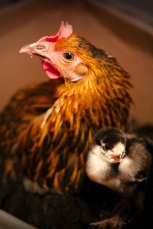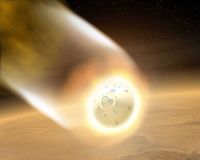
Earlier today, the Rosetta lander Philae successfully docked with the comet it’s going to study, 67P/Churyumov-Gerasimenko! By now, the lander is busily doing science on the surface of a comet. Not bad for a robot built by a bunch of curious apes! Congratulations to everyone involved, and thanks for all the hard work!
Over the next few days, Philae will take plenty of pictures of the landing site, analyse the comet’s surface materials, drill out a chunk of the comet for analysis in the onboard laboratory, and measure the electrical and mechanical properties of the surface. It will also cooperate with Rosetta to study the comet’s internal structure by sending low-frequency radio waves through it. Philae’s primary battery will only last for a few days; after that, a secondary, rechargeable battery may keep it going until March if the solar panels don’t get blocked.
Rosetta’s job isn’t over yet. While Philae is studying the comet up-close, the spacecraft will keep orbiting the comet as it gets closer and closer to the Sun. In August, the comet will be at its closest to the Sun — ‘only’ 185 million kilometers, which is still slightly farther out than the Earth’s orbit. Rosetta will ride through the approach and stay with it on the outward journey, beaming back data the whole way. So there’s a lot to look forward to from Philae in the coming days and from Rosetta in the coming months!
Image credit
The picture, courtesy of the ESA, was taken by Philae during its descent; the lander was about 3km above the comet’s surface. Congratulations to the Rosetta team!
 It’s probably not a surprise that humans aren’t the only animals with a sense of numbers. While they’re probably not actually counting, a variety of species seem to be able to tell the number of objects in a group; they can distinguish between groups with greater or fewer objects and react with surprise when the number changes unexpectedly. However, a recent study suggests that this numerical understanding may go deeper than we’ve previously thought. Continue reading
It’s probably not a surprise that humans aren’t the only animals with a sense of numbers. While they’re probably not actually counting, a variety of species seem to be able to tell the number of objects in a group; they can distinguish between groups with greater or fewer objects and react with surprise when the number changes unexpectedly. However, a recent study suggests that this numerical understanding may go deeper than we’ve previously thought. Continue reading 



You must be logged in to post a comment.